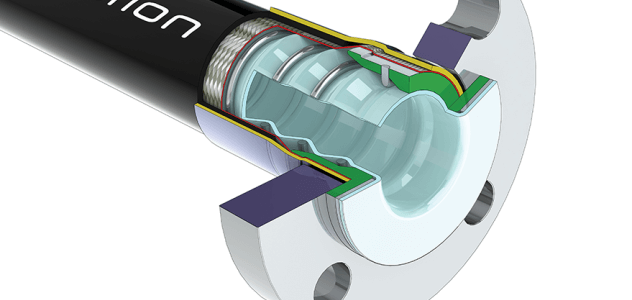TEMPERATURES, PRESSURES & FLOW RATES
Temperature vs Pressure
Maximum Working Pressure (MWP) Variation with Temperature:
Hose with SS Braid as per Graph.
Hose with PB Braid, pressure as listed from -30˚C to +80˚C and 50% less from 80˚C to 100˚C.
Hose with RC, FP and SI grades as per Graph, BUT only within the temperature range for the particular grade of rubber cover, as given below.
Maximum Operating Temperatures (Internal Fluid Only) for different hose grades:
SS -73˚C to +260˚C
PB -30˚C to +100˚C
SS,RC & SS, FP -40˚C to +150°C
SS, SI -73˚C to +224˚C
KYB -40˚C to +120˚C
(Subtract 20˚C from the above maximum temperature limits if the temperature is external to the hose).
Temperature vs Vacuum
All sizes of Corroflon GP,SS and AS, SS are usable at vacuum to -0.9bar up to 150˚C up to 2”. Above this, the vacuum resistance should be reduced 1% for every degree above 150˚C.
Other grades the same, BUT ONLY within the temperature limits for the particular hose grade.
Temperature & MWP Graph for Corroflon GP, SS and AS, SS
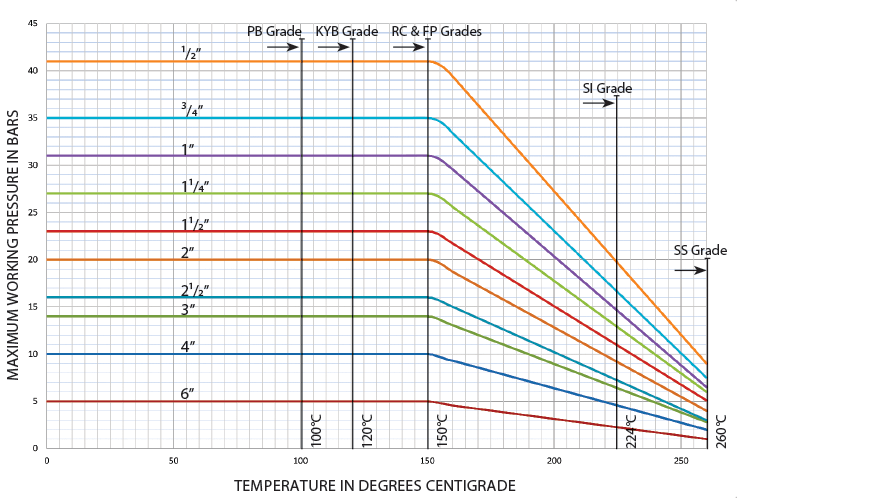
Flow Rates
For maximum flow rates, it is better to use the smoothbore Bioflex hose if possible, because the convoluted bore of Corroflon creates turbulent flow, which reduces flow rates.
Corroflon Hose – Flow Rate Calculation
If it is required to determine the flow rate of a particular hose assembly, or if it is required to determine the pressure required to generate a certain flow rate, then this can sometimes be approximately calculated by the Corroflon supplier.
It should be noted that calculations can only be made for fluids with a viscosity equal to water, and for hose assemblies with PTFE lined end fittings (no bore restrictions at the ends of the hose).
The following information should be given to the supplier:
To calculate the Flow Rate in Cubic Metres per Hour:
Pressure Drop over the Hose Length = Pressure in Bars at the Entry into the hose assembly – Subtracted from – Pressure in Bars at the Exit from the Hose assembly
The hose configuration (roughly straight, or 33% Bends, or 66% Bends, or 100% Tightly Coiled)
OR To Calculate the Pressure Drop in bars over the length of the Hose Assembly:
Required Flow Rate in Cubic Metres per Hour
The hose configuration (roughly straight, or 33% Bends. or 66% Bends, or 100% Tightly Coiled)
Whistling
A ‘whistling’ noise may be created by turbulent flow when steam or other gasses are passed through a Corroflon hose at high flow rates. In such applications, Bioflex hose represents an alternative option which eliminates this problem.
SIZES, GRADES, BEND RADII & DIMENSIONS
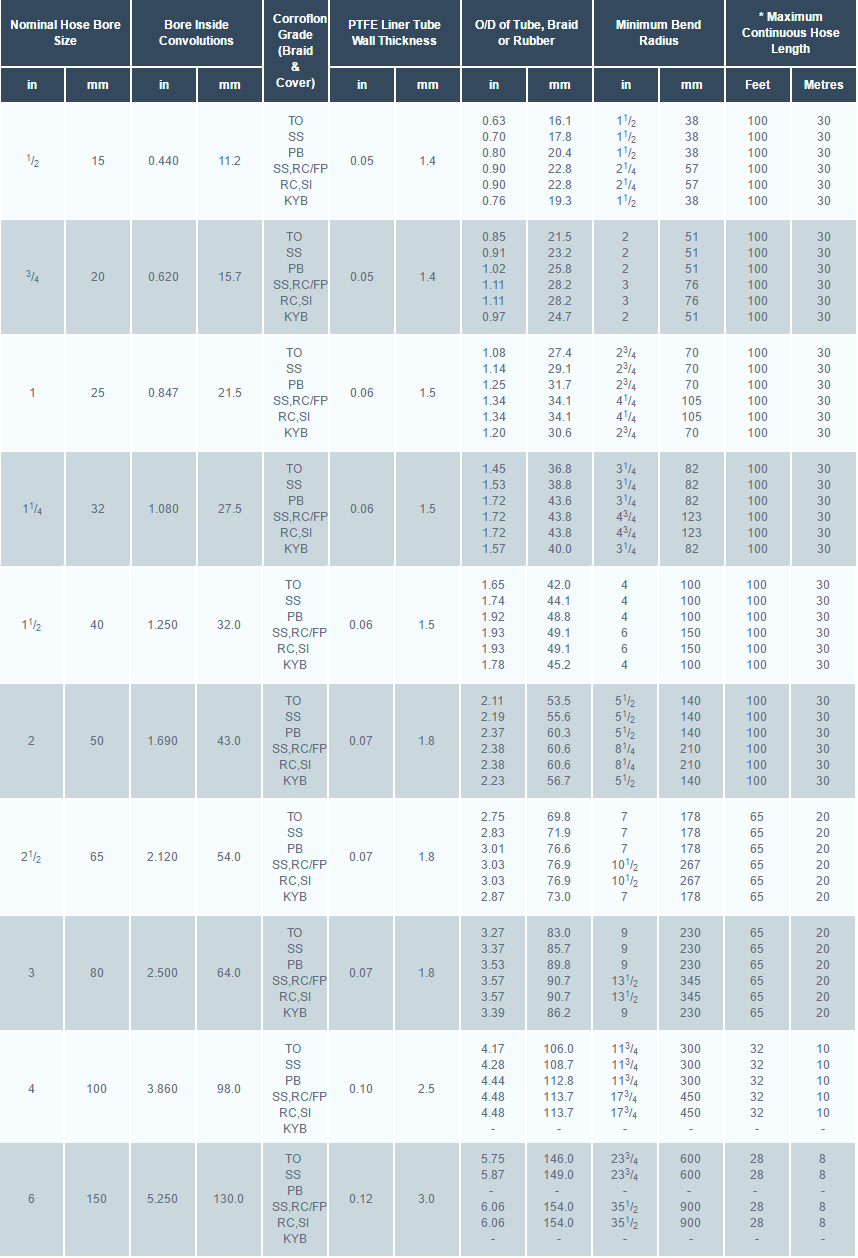
*Longer lengths may be available to special order if needed.
SIZES, GRADES, PRESSURE RATINGS, WEIGHTS
Corroflon Sizes, Grades, Pressure Ratings & Weights
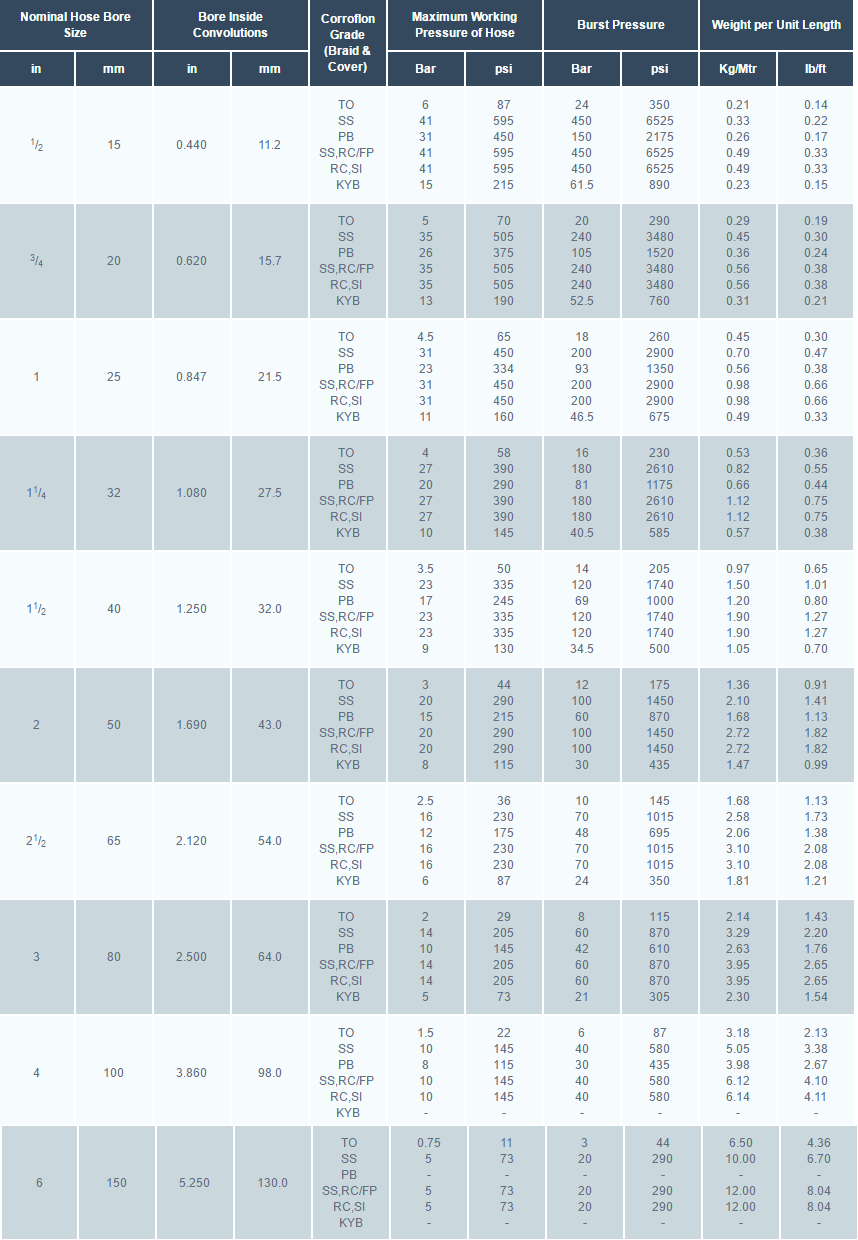
Cleaning & Sterilising Systems – CIP, SIP and Autoclave
CIP & SIP – PTFE liner tubes are chemically resistant to all CIP, SIP and Autoclave conditions. The primary consideration is whether the cleaning and purging cycle is likely to develop an electrostatic charge on the internal surface of the liner, in which case AS (Anti-Static) grade hose is required.
AS grade hose and Electrostatic charge generating systems are fully described in the hose liner section.
CIP systems using high electrical resistivity solvents like Toluene will require AS grade hose.
Another electrostatic generation problem arises when wet steam is used, or when the cleaning fluids or WFI are purged out of the line using nitrogen, compressed air or another gas, because droplets of liquid or water in the gas then generate a multi-phase condition until they are cleared out, which will generate a static charge, and so will require AS grade hose.
In static generating applications where AS grade hose is not acceptable due to the black PTFE liner, alternative solutions are available – please consult Aflex Hose for advice.
Autoclave – Autoclave sterilisation does not normally involve any high flow rates through the hose bore, so static generation is not a problem. Aflex hose grades GP and AS, with SS or HB braids are fully resistant to all autoclave conditions throughout the service life of the hose.
The rubber covered grades EPDM, (RC) and Silicone Rubber (RC, SI) are able to withstand at least 100 x 30 minute autoclave cycles at relatively high autoclave temperatures (121°C, 250°F or 135°C, 275°F). Consult Aflex Hose for more specific information.
PTFE Hose-Use with Alkali Metals, Halogens and Halogen containing Chemicals
PTFE hose liners react chemically with Fluorine, Chlorine Trifluoride and molten Alkali Metals.
When PTFE lined hose is used to carry Chlorine or Bromine, either as gasses or fluids, they will diffuse into and through the PTFE liner wall thickness. Trace quantities will then combine with atmospheric moisture to corrode any braid/rubber outer coverings.
Heavily halogenated chemicals, like Hydrogen Fluoride, Hydrogen Chloride, Phosgene (Carbonyl Chloride) Carbon Tetrachloride and other organic chemicals with a high halogen content can also be absorbed and transmitted through the PTFE liner tube.
Other “Penetrating” Fluids and Gases
Sulphur Trioxide, Methyl Methacrylate, Caprolactam and Glacial Acetic Acid are some other chemicals which can be absorbed and transmitted through the PTFE liner tube wall.
Generally, however, as a hydrophobic (non-wetting) material, PTFE is very resistant to the absorption of chemicals. In some cases, PTFE has superior resistance to diffusion, for example to the diffusion of automotive fuels, in comparison with all other plastics and rubbers.
Gas/Fluid Cycling
There are some applications where the fluid passing through the hose turns into a gas, then back into a fluid, then into a gas etc, in a cyclic sequence.
This is normally associated with changes in temperature and/or pressure. For complex reasons these conditions are extremely damaging to the hose liner, whatever material it is made from.
For example, hoses are sometimes used to pass steam, water, steam etc into rubber moulding presses, in order to heat the mould, then rapidly cool it before reheating in the next cycle. Hoses of all types fail rapidly in such an application and PTFE lined hoses are no exception.
Please contact Aflex Hose for further information if these conditions apply.
Connecting Assemblies for Use in Applications
The lengths of hose assemblies and their configuration in use when connected into the application must always be in accordance with the Hose Configuration information at the end of this product literature.
When being connected for use in applications, the end fittings on hose assemblies must be connected to correct mating parts in the correct way, using the correct tools, spanners, clamps, nuts and bolts etc. The connections must be sufficiently tightened to ensure that the joint is leak free but not be over tightened as this can damage the sealing surfaces, especially with PTFE lined and flared end fittings.
In applications involving the transfer through the hose of expensive or dangerous fluids or gases, the hoses and connections must be pressure tested in situ before being put in to service. This should be done with some harmless media to 2.0 times the maximum working pressure of the hose assembly, as stated in the product literature.
If in doubt please contact Aflex Hose for advice.
Special Applications
Aflex Hose PTFE lined hose products are not rated as suitable for use in the following, special applications:
- All Radioactive Applications involving high energy radiation, including Gamma radiation (degrades PTFE)
- All Medical Implantation Applications.
- All Aerospace Applications.
Silicone-Free Application Requirements
Some applications, particularly paint manufacturing plants, and other specialised applications require that hoses do not include any silicone containing materials in their manufacture (which is possible), or sometimes that hoses are 100% Silicone Free (which may not be possible). Customers or Distributors must identify and define any such requirements in writing on all enquiries/orders.
GP – General Purpose Liner
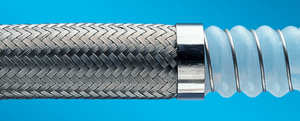
Purpose
Corroflon GP, SS is the general purpose grade of hose and has been carefully designed to satisfy the widest range of application requirements.
Design & Approvals
The hose liner is manufactured from hose quality grade PTFE conforming to FDA requirements 21 CFR 177.1550 extruded into tube and helically convoluted. It also includes a heavy gauge Grade 304 stainless steel reinforcing wire helically wound into the external root of the convolutions to strengthen the convoluted shape. The braid is high tensile grade 304 stainless steel wire braid to give maximum protection to the hose against internal pressure and external abrasion.
Corroflon GP hose liner tube also conforms to USP Class VI at normal temperatures and at 121˚C (250˚F), see Quality Assurance & Certifications.
AS – Antistatic PTFE Liner
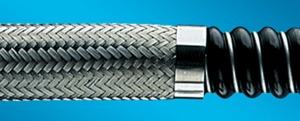
Purpose
Corroflon AS grade is an essential requirement in applications where there is the risk of an electrostatic charge build-up on the inside surface of the PTFE tube which may then discharge through the tube wall. Media passing through which create such a risk are fluids which have a Conductance of less than 10-8S/m (Siemens per Metre), or 104 pS/m such as fuels, solvents, freons, some WFI (ultra-pure “Water for Injection”) and non-polar organics which are being transferred at a medium to high flow velocity.
All twin or multi phase media, and any non-mixing media, such as powder in air, or water droplets in steam, in gases or in oil, also colloidal fluids constitute a particular hazard for static charge generation, and always require grade AS.
A typical example involves cleaning systems which create a twin phase mixture passing through the hose at high velocity, such as WFI water purged out with air or nitrogen.
If in doubt, consult Aflex Hose.
Design & Approvals
Corroflon AS grade has an anti-static PTFE liner manufactured from FDA 21 CFR 177.1550 approved PTFE, and less than 2.5% of “high purity” Carbon Black material to FDA requirement 21 CFR 178.3297 and European Commission Directive 2007/19/EC. The carbon is encapsulated by the PTFE, and in normal, non-abrasive applications will not come loose to contaminate any fluid passing through. (This has been confirmed by Extractables and Leachables Tests in accordance with BPSA recommendations).
Corroflon AS hose liner tube also conforms to USP Class VI at normal temperatures and at 121˚C (250˚F), see Quality Assurance & Certifications.
Antistatic Hose Assemblies
When “AS” (Antistatic) grade hose is specified, then the hose or hose assembly supplied will be tested in accordance with EN ISO 8031 and meet the Antistatic requirements of EN ISO 8031 Annex A. This requires, for an antistatic liner or antistatic cover, that the resistance between an appropriately placed foam electrode and a metallic end fitting will be between 103 to 108 ohms per assembly. For hose assemblies which meet these requirements an appropriate Grade “Ω” marking can be applied in accordance with EN ISO 8031 Annex A if requested.
Note: When in service, at least one end fitting must be connected to earth, to permit dissipation of the static charge from the end fitting.
SP – Special Purpose Liner
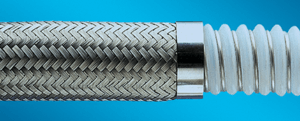
Purpose
For applications requiring a higher temperature/pressure rating, greater flexibility and improved kink and crush resistance. Also for applications requiring full vacuum resistance for hose sizes larger than 2”.
Design
The convolutions are closer together, yielding greater radial strength to the hose design.
Specifications
As for Corroflon GP, except that the maximum working pressure for wire braided grades is increased by 25%, the weight per metre is increased by 30%, the actual through bore is reduced by 1/8” (3mm), the maximum continuous length is reduced by 50%, the minimum bend radius is reduced by 25% and the angle of cleanability is <80˚.
Available as SP (Natural) and SP, AS (Antistatic) Grades.
SG – Safegard Protection Sleeve
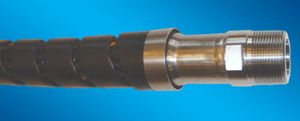
Purpose
To protect the hose against external abrasion and mechanical damage. For use in applications where maximum external protection is required with minimum extra hose weight. Particularly useful with PB or KYB hose, where a rubber cover is not an option.
Design
A lightweight black, HDPE (High Density Poly Ethylene) strip spirally wound around the outside of the hose over its whole length, secured to each end fitting by crimping under a SS ferrule.
Limitations
Safegard is applicable to all hose types and all hose sizes from 1/2” up to 4”.
Safegard is limited to use within a temperature range from -40˚C (-40˚F) up to +100˚C (212˚F). Internal fluid temperatures up to 120˚C (250˚F) are acceptable, when external temperatures are ambient.
The minimum hose assembly length must be doubled, if Safegard is being used and the maximum assembly lengths for all sizes are capped at 20 metres (65 feet).
The other hose usage limitation specifications are not altered by the addition of Safegard.
SR – Scuff Rings
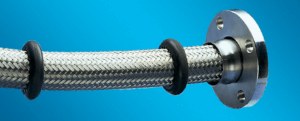
Purpose
For medium duty applications where the hose requires some protection against abrasion when dragged over the ground, but where a full rubber cover would be too heavy and cumbersome. Also for PB and KYB braided hose, which cannot be Rubber Covered.
Design
Specially moulded abrasion resistant rubber scuff rings are placed every half metre along the hose.
Limitations
Available for hose sizes 1” (25mm) to 2” (50mm) only. The operating temperature should not exceed 140˚C (284˚F) (internal).
PC – Protection Coil
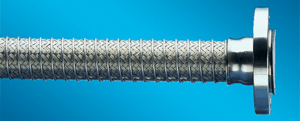
Purpose
For applications where the hose requires protection against abrasion when dragged over the ground, but where any rubber reinforcement is not permissible due to temperature, chemicals etc.
Design
A stainless steel wire helix is wound onto the braid and welded to the ferrules at each end.
Limitations
Available for all sizes and grades of hose, including rubber covered.
The maximum assembly lengths for all sizes are capped at 20 metres (65 feet).
Specifications
As for the relevant hose grade.
SS – Stainless Steel Braid
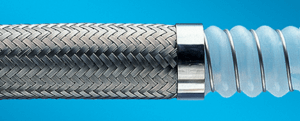
Purpose
Stainless Steel braided hose is the general purpose product, and can be used in applications involving high temperatures and working pressures. High tensile AISI 304 stainless steel wire is used, to give maximum pressure resistance and external protection to the hose.
PB – Polypropylene Braid
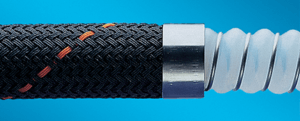
Purpose
Polypropylene braided hose is often preferred to SS in applications involving frequent handling and movement of the hose, and where temperatures are within the range -30˚C to +100˚C (-22˚F to +212˚F). PB braid is lighter in weight, and any broken strands will not cut the operator’s hands. In addition, PB braid is not prone to “chloride stress corrosion”, and has generally good chemical resistance.
Note: Prolonged exposure to sunlight eventually results in UV degradation of PB braid.
KYB – Kynar Braid (Polyvinylidene Fluoride Monofilament)
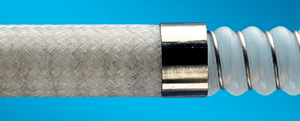
Purpose
Kynar Braid is used in the same application as Hastelloy Braid, but only in applications where the reduced pressure ratings of KYB as listed are acceptable. A Safegard Sleeve is always recommended. Monel or Hastelloy wire should be used.
Full details about the applications should be given to Aflex Hose for evaluation and recommendations.
TO – Tube Only (no braid)
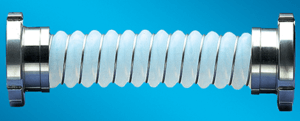
Purpose
TO grade hose (available in both GP and AS) is a lightweight hose, used in applications where working pressures are low and where there is no need for the physical protection offered by an external braid.
HB – Hastelloy Braid (C276 grade)
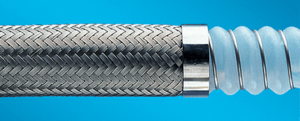
Purpose
Hastelloy Wire Braid is used instead of SS where severe chemical corrosion conditions exist around the outside of the hose. The most usual way in which this can happen is when Chlorine, Bromine, Hydrogen Fluoride, Hydrogen Chloride or Phosgene are being transferred. Diffusion of trace quantities of such fluids or gases through the PTFE liner can lead to atmospherically wetted halogen chemicals attacking the braid material, in which case the Hastelloy Braid would be resistant up to 60˚C (140˚F) maximum. This should only be used, however, in conjunction with a Monel or Hastelloy Helix Wire.
Full details about the applications should be given to Aflex Hose for evaluation and recommendations.
Specifications
Same as for SS in Specifications & Properties, except the Burst Pressures and the Maximum Working Pressures are both reduced to 80% of the SS pressures listed.
Also, the sizes range is restricted, from 1/2”up to 2” bore only.
SPECIAL NOTE:
EC – Electrical Continuity (Also known as “Electrically Bonded”)
The requirements for this are specified in the German Document BRG 132 and EN ISO 8031 Annex A, when tested in accordance with EN ISO 8031, which requires that the resistance between end fittings shall be <102 ohms per assembly. For hose assemblies which meet this requirement a Grade “M” marking can be applied in accordance with EN ISO 8031 Annex A if requested.
RC – EPDM Rubber Covered – Antistatic and Fire Proof Black Rubber Cover

Purpose
For the most rugged applications where the hose may be subjected to rough treatment and severe external abrasion. Also for hygienic applications, where the external cleanability of the hose is of prime importance and in applications where the hose is required to be Fire Proof, or to have an Antistatic cover.
Design
An SS braided hose has a black, antistatic EPDM external rubber cover extruded directly onto the braid to produce a super-smooth external surface finish. Sizes above 2” bore are hand-wrapped, not extruded.
EPDM has excellent chemical resistance, and the hose has a temperature range from -40˚C, -40˚F up to +140˚C, +284˚F.
Fire Proof
As well as providing an Antistatic cover, Corroflon RC hose is also Fire Proof in accordance with Specification BS5173 Section 103.13 part 6.2 (Fireproof). This specification calls for an 1100˚C (2012˚F) flame to be applied to the hose at minimum bend radius, maximum operating pressure (water), and one end fitting under vibration. The hose must withstand at least 15 minutes without leakage.
Hose assemblies are Fire Resistant, but can be rendered Fire Proof by the addition of DRC-300 at both ends – see below.
Corroflon RC hose meets the requirements of German Safety Regulation TRBF 131/2.
SI – Silicone Rubber Cover
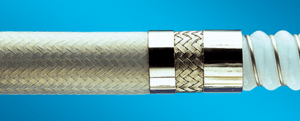
Purpose
As for RC hose, but where the hose may be required to withstand temperatures from -73˚C, -100˚F up to +204˚C, +400˚F. SI grade hose is semi-transparent, allowing visual monitoring of the braid.
Design
An SS braided hose assembly has an external smooth finish, platinum cured silicone rubber cover extruded (>50 metres) or hand-wrapped (<50 metres), and vulcanised directly onto the braid.
Specifications
The Silicone rubber cover has been tested and conforms to the requirements of USP Class VI, see Quality Assurance & Certifications.
RC-300 – Rubber Covered 300mm at End
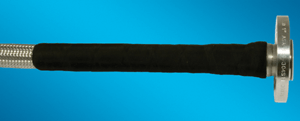
Purpose
In applications where excessive flexing of the hose at the end fitting occurs, it is sometimes necessary to ‘stiffen’ the hose in this area, to prevent kinking.
Design
A layer of rubber is hand-wrapped and vulcanised directly to the ferrule, and 300mm (12 inch) along the hose from the fitting. This can be done either on an SS braided hose (RC-300 or SI-300) or on a rubber covered hose as a 300mm (12 inch) long double layer of rubber at the end (DRC-300 or DSI-300).
